FAQs on Identification of
Stinging-Celled Animals 26
Related Articles: Cnidarians, Water Flow, How Much is Enough,
Related FAQs: Cnidarian
IDs 1, Cnidarian IDs 2, Cnidarian IDs 3, Cnidarians ID 4, Cnidarians ID 5, Cnidarians ID 6, Cnidarian ID 7, Cnidarian ID 8, Cnidarian ID 9, Cnidarian ID 10, Cnidarian ID 11, Cnidarian ID 12, Cnidarian ID 13, Cnidarian ID
14, Cnidarian ID
15, Cnidarian ID
16, Cnidarian ID 17, Cnidarian ID 18, Cnidarian ID 19, Cnidarian ID 20, Cnidarian ID 21, Cnidarian ID 22, Cnidarian ID 23, Cnidarian ID 24, Cnidarian ID 25, Cnidarian ID 27, Cnidarian ID 28,
Cnidarian
ID 29,
Cnidarian ID 30,
Cnidarian ID 31,
& Anemone ID 1, Aiptasia
ID 1, Stony Coral ID 1,
Mushroom
Identification, Soft Coral ID, Alcyoniid ID, Xeniid ID, |
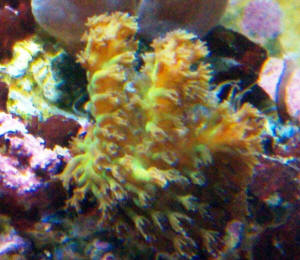
|
|
Hello WWM, I need help identifying a specimen! --
12/28/10
Hello Crew @ WWM! Here's the story. I have a 10g small reef
setup (stable and actually growing corals under T8, blasphemy I
know). As a means of algae control in my tank I have assorted
hermits, snails, and one emerald crab.
<Mmm, predaceous>
The emerald crab has a penchant for rearranging my rock
structures (they're all small rocks due to limited tank
size). Upon a recent crab-induced renovation I spun a rock around
and later the next night found to my surprise two
"polyps". I use quotations because I cannot actually ID
these (thus writing you). My difficulties to ID them stem from
the fact that their bodies are almost completely clear, and by
eye I can only make out the mouth and little white tips of the
tentacles. Cameras seem to fare much worse, and with a flash it
becomes too bright to see anything other than the mouth, and
without it is too dark to make out the white tips on the
tentacles, no happy medium with my phone camera unfortunately.
The body of the specimens are both growing inside of a small
holes in the rock itself, and they seem to be about 1/4"
wide. They are growing on the side of the rock, out of direct
lighting and in a high current area. Their tentacles appear to
stay very close to the rock, radiate perhaps another 1/4"
outward, and in my observations I didn't notice any waving
movement. There does appear to be some sort of skeletal
feature inside the hole, but I can't be sure as it
is so small. Under actinic light there is a small ring of
fluorescing specks around the outside edge of the oral disc.
http://picasaweb.google.com/xxfallacyxx/DropBox?authkey=Gv1sRgCMnuh7SQmf3S8g
E#5555535619293921986
Using the tools on Picasa web you should be able to zoom in and
get a look at the specimen.
<Too little data to expand>
When looking at the picture notice the "spur" of rock
at the top. If you follow the left side of the "spur"
directly down you will notice a sudden bright spot (sort of a
fleshy color). This is where the specimen is, and the small white
dots surrounding it are the tips of it's tentacles. Any help
you can offer in IDing this specimen is greatly appreciated! Hope
your holidays were great, and wish you a good new year.
<Can't make out what you're referring to, but from
your desc. these are likely Stony/Scleractinian polyps of some
sort, perhaps singular species. Take the long read staring here:
http://wetwebmedia.com/stonycoridfaq.htm
and the linked files above, where you lead yourself. Bob
Fenner>
|
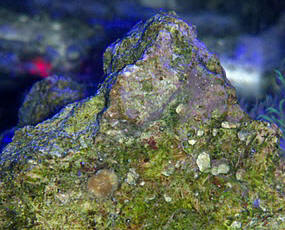 full size crop full size crop |
Re: Hello WWM, I need help
identifying a specimen! -- 12/28/10
Thank you for your quick response. I understand the difficulty in
seeing what I was talking about in the picture as the specimen is
as I mentioned almost completely clear. I read the article and
found a similar looking specimen which was referred to as
"Rhizangiids".
<Yes; a possibility... there are other families... notably some
of the Caryophylliids, now Euphylliids>
A quick Google search led me to a different WWM article where I
found a picture of something that is almost spot on to what I have.
The article is
LINK< http://www.wetwebmedia.com/CnidIDF19.htm>
and the inquiry is titled "*Interesting Hitchhiker:
Pseudocorynactis -- 6/14/09".
<Ahh!>
*The second of the two pictures attached to that inquiry is very
similar to what I have. It's referenced as a Pseudocorynactis,
however due to it's small size I believe it may actually be a
member of the genus Corynactis.
<Maybe>
Just replying to say thank you, as even though you didn't
provide a direct answer you did link to something I don't think
I would have found on my own as I wasn't looking into
Stony/Scleractinians as possible culprits.
<Thank you for this follow-up. BobF> |
Colonial Anemone/Parazoanthus?
12/22/10
Hi Crew,
<Howdy Jim>
So far I have had my tank (29G reef) set up for about a year now.
Despite some algae and pH problems which I'm working to get
in-line everything seems to be doing well. I have used your site
for a reference for the past year and so far it has been a great
resource and I haven't had to ask any questions directly up
until now (thanks!).
<Welcome!>
It seems that every week or so I still notice something new in the
tank.
Lately I have seen 3 colonies of these "polyps" in my
tank. From some research on your site and elsewhere, the only
conclusion I can come up is that they are some kind colonial
anemone or Parazoanthus.
<Mmm, am pretty sure these are Aiptasiids... the family of Glass
Anemones.
Please see here:
http://wetwebmedia.com/marine/inverts/cnidaria/anthozoa/aiptasia/aiptasiaidfaqs.htm>
They don't seem to respond to changes in light like a tube
worm, although when I prod them with an object they seem retract
into their rigid tube. They are only a few mm wide and long.
<Oh! Small thus far>
Do you believe these will become a problem if they start spreading
throughout the tank?
<Could be if they begin to squeeze out other life, perhaps
stinging your livestock>
Should I remove them, or just monitor them for now?
<If not too numerous... I'd just watch/see. Do see the
related links above the citation re controls of various
sorts>
Please see attached photo.
Thanks,
Jim
<Welcome and happy holidays. Bob Fenner> |
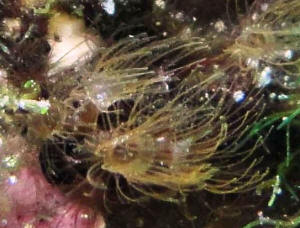 |
Re: Colonial Anemone/Parazoanthus?
12/22/10
Hi Bob,
<Hello again Jim>
Thanks for the prompt response! I had thought they might be
Aiptasia at first, but from my research I thought I remember
reading somewhere that these creatures don't retract into a
tube, but when they retract, they usually retract their whole
body into hiding (making them hard to get at).
<Yes and yes>
The ones in my tank definitely leave a visible tube behind after
retracting so it is the only thing that made me doubt they were
Aiptasia.
<Me too if so>
I will monitor and take action if necessary.
<Okay!>
By the way I have a copy of your Conscientious Marine Aquarist
and found it also to be a great resource. I wish I would have
just followed your advice from the book regarding the size of the
setup. I think a larger tank would have just been easier from the
beginning (despite the objections from the wife!).
<Heeee! Woulda coulda shoulda. Perhaps a "trade of
sorts" w/ your spouse.
Is she opining re something she'd like...?>
Happy Holidays and thanks again,
Jim
<Oh Jim! These may well be Hydrozoans/Hydropolyps based on
morphology, size, tube-dwelling habit and withdrawing behavior.
And to you and yours. Cheers,
BobF>
Re: Colonial Anemone/Parazoanthus?
12/22/10
I hope not!
<Heeee! If fishes were wishes, we'd all have full
tanks!>
I even thought about Hydroids; I just wasn't aware that they
also could withdraw into a tube. They are definitely colonial in
nature and so far I see three colonies in the tank, with this and
another appearing most recently. The third has been around for at
least two months and has about 12 members.
<Mmm, but not in one patch/batch...>
For what it's worth, I was taking a look at them again and I
noticed some worms and even my peppermint shrimp touching the
polyps (causing the polyps to retract) and none of the animals
involved seemed to recoil in pain.
<Good>
They also don't seem to be connected like I have noticed in
some other hydroid pictures but I'm not sure if this is a
prerequisite or not.
<Solitary Zoanthids are rare>
I only came to the conclusion that it might be some kind of
Parazoanthus because the tentacles seemed to be long and
"stringy" as compared with some of the other pictures
I've seen of that genus. Then again many Hydroids seem to
share this trait as well.
<Yes>
I will definitely keep an eye on them. Thanks again. You and your
crew do an awesome job.
Jim
<Glad to share. BobF>
Re: Colonial Anemone/Parazoanthus?
12/30/10
Hello again Bob,
<Hi Jim>
After a little more investigative work, I think I may have
found what these creatures are (at least narrowed it down a
bit).
I first found something that looks fairly similar (although
not exact) on this link here: http://www.masa.asn.au/masawiki/index.php/Nausithoe
The author there describes it is a Nausithoe.
<Ah yes>
I also found a reply from Ron Shimek on another forum:
http://forum.marinedepot.com/Topic46856-11-1.aspx?Highlight=id
He states, in reference to one of the images there that:
"The four-lobed nature to the mouth is clearly evident,
and that means that they are scyphozoan polyps"
<This is so>
I attached the original photo with the mouth circled and you
will see the resemblance.
Just thought I would share my findings.
Thanks again and have a happy New Year!
Jim
<And to you! BobF> |
|
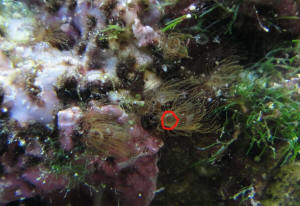 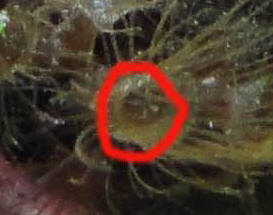
|
|
Hitchhiker Coral ID/Aiptasia
10/17/10
Hey crew,
<Andrew>
I just want to start out saying that your website is just plain
amazing.
I'm really glad I found it over a year ago when I first started
keeping a salt water tank. Needless to say, it's saved me from
quite a few headaches so thank you all for all your hard work.
:)
<You're welcome.>
My question though is about a coral that seems to have hitchhiked
onto a piece of rock that came with a Colt Coral I ordered online a
while back. At first when I received my colt, I noticed there was a
small speck of something living on the rock but didn't think
much of it. Now almost half a year later that "speck" has
turned into a decent sized coral (about the size of a quarter now)
that has made it's home on the rock with my colt and a nice
piece of Xeniid that slowly traveled across the tank. So any ideas
what it could be? I've tried looking cover to cover in
Anthony's book on propagation for anything that even closely
resembles what I have with no luck. The galaxy coral was the only
thing that looked a little close but
god forbid I have one of those so near my colt and xenia! Any help
would be greatly appreciated so I can figure out what to do with
the little guy.
Thanks in advance!
<If you are referring to the anemone like creature to the right,
this is not a coral but appears to be an Aiptasia Anemone, an
unwelcomed pest that can reproduce and rapidly take over an
aquarium. See here.
http://www.wetwebmedia.com/marine/inverts/cnidaria/anthozoa/aiptasia/aiptasia.htm
More ID photos here.
http://www.google.com/images?q=aiptasia&rls=com.microsoft:en-US&oe=utf8&um=1
&ie=UTF-8&source=univ&ei=jva6TOmYMJKqngfn8f2eCA&sa=X&oi=image_result_group&c
t=title&resnum=2&ved=0CCgQsAQwAQ&biw=1579&bih=603
James (Salty Dog)>
-Andrew |
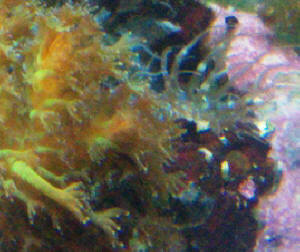
|
Re Hitchhiker Coral ID/Aiptasia
10/17/10 = 10/18/10 RMF, Any Idea?
Hi James,
<Hello Andrew>
Actually I was referring to the greenish/yellow bush-like
coral in the foreground. It appears to have a yellowish
stalk-like skeletal structure, almost like an Acropora, in
which the polyps extend from except the polyps themselves
resemble those found on a Xeniid or even a Star Polyp
except they don't retract back into the structure.
<Mmm, my best guess is a Xeniidae species. Any idea
Bob?> <<I agree w/ your guess. RMF>>
I've attached a couple more photos of it for you.
<Thank you, but no need to send multiple photos of the
same image. James (Salty Dog)>
|
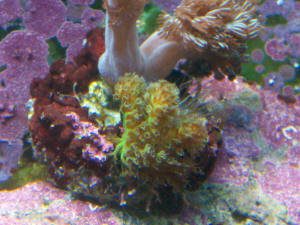  |
|
|
|

